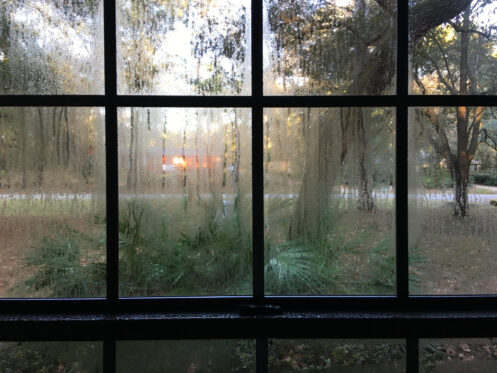Denver and Colorado Springs are known for their four seasons of semiarid weather, featuring generous sunshine and extended low-humidity periods. We get dry, cold winters and arid summers characterized by low moisture in the air. For many residents, the overlapping desert and mountain air is too dry for comfort; you know this when your skin feels tight and your throat gets scratchy.
In winter, heating and ventilation can leave indoor air overly dry. A simple solution would be to install a humidifier; however, this may not always be the right move. When summer rainstorms roll through our service areas, the relative humidity rises considerably, thus making a humidifier counterintuitive. If you deal with a skin or respiratory condition exacerbated by high humidity, or if you have living spaces prone to dampness, a humidifier can make things worse.
A dehumidifier, on the other hand, is your best friend when the indoor air becomes too heavy with moisture. While this isn’t a year-round concern in our semiarid climate, our region can experience surprisingly humid conditions, particularly during summer. If you notice condensation on windows, a musty odor in basements or bathrooms, or clammy skin, a dehumidifier would extract excess moisture to increase comfort. You can breathe easier with this solution, which helps in preventing mold and mildew growth.
This is where the humidifier vs. dehumidifier debate comes in. It relates to indoor air quality (IAQ), which we provide services for at Alphalete Plumbing Drain Heating & Air to homes and businesses across Denver and Colorado Springs. Let’s explore the pros and cons of humidifiers and dehumidifiers so that you can understand the strategies we apply to promote IAQ in your living spaces.
Controlling Humidity Through IAQ Solutions
IAQ refers to the quality of the air within and around buildings, especially as it relates to health and comfort. Managing humidity is a significant aspect of IAQ, but it’s not the only factor.
The filters in your heating, ventilation, and air conditioning (HVAC) system contribute to IAQ. Advanced filtration tools like HEPA filters do more to improve IAQ by trapping allergens and contaminants. Energy or heat recovery ventilators (ERV/HRV) systems bring in fresh air and exhaust stale air, while air scrubbers filter recirculated air. Ultraviolet lights can inactivate certain microbes (bacteria and viruses) when properly engineered and well-maintained.
Humidity control is the IAQ service most frequently requested by Alphalete Plumbing Drain Heating & Air customers. All HVAC systems provide some level of humidity control; for example, central air conditioning dehumidifies the air while cooling by pulling air through the return vents and through the ductwork. As the system passes air over the evaporator coil, the resulting condensation gets drained before cool air is distributed throughout the living spaces.
Keeping your HVAC system in optimal condition through regular maintenance and tune-ups is a basic IAQ strategy; nonetheless, it is not sufficient in all situations. In households and workplaces where individuals live with chronic respiratory conditions, overly dry air can irritate the nasal passages and throat, thus worsening symptoms. Dry skin, eczema, and psoriasis are dermatological conditions that would benefit from more humid IAQ. Conversely, fungal rashes, asthma, and some respiratory allergies would require a dehumidifying IAQ strategy to prevent flare-ups.
Beyond health reasons, controlling humidity through IAQ solutions offers material protection advantages. At Alphalete Plumbing Drain Heating & Air, we’ve seen situations in which severe moisture level fluctuations can cause damage to fine furniture, electronic equipment, paper document archives, books, antiques, and other valuable items. With the right IAQ solutions, you can effectively safeguard personal property and equipment.
Do You Need a Humidifier or Dehumidifier?
The answer should depend on your needs. As mentioned above, basic IAQ begins with proper HVAC maintenance, which should be seasonal. If a health professional recommends humidifying for severe eczema, there’s your answer. If a physician determines that your seasonal allergies are exacerbated during the rainy season, a dehumidifier would be ideal.
At many commercial properties, business owners and managers choose to install both humidifying and dehumidifying equipment. Examples range from hospitals to art galleries, restaurants, warehouses, and data centers. These are mission-critical IAQ solutions.
Aim for 30–50% indoor relative humidity. Use a humidifier below 30% and a dehumidifier above 50%.
Deciding between a humidifier and a dehumidifier, or perhaps installing both solutions, begins with an IAQ audit. Alphalete Plumbing Drain Heating & Air technicians know everything about how climate conditions in Denver and Colorado Springs impact HVAC functionality in both dry and rainy seasons. During an audit, they use advanced hygrometry tools to measure indoor moisture and compare it to recommended levels. We can complete the process during any season; for example, a December audit will likely result in lower humidity, but we can estimate what it would be when the rainy season peaks.
You can present our IAQ reports with their moisture levels to your doctor for a more informed recommendation. We also consider other factors that should guide your decision, like whether a portable unit in a bedroom would be sufficient or if you need a whole-home solution. If you want to protect equipment and material from drastic humidity fluctuations, you can use the reported moisture levels to check against technical specifications and recommendations.
HVAC Moisture Control Solutions
Humidifiers and their counterparts fall under two major categories: portable and whole-home. More specifically, you can choose forced-air systems with evaporative, self-contained, or steam mechanisms. The solutions vary for heat pumps and ductless mini-split systems.
Portable units are self-contained devices that manage humidity in a single room or localized area. You can move them between living spaces easily; they are ideal if you only need to control moisture in one room, and they are often installed when physicians recommend immediate humidity control. Whole-home systems integrate directly into your existing HVAC system to treat the air in all living spaces. When you choose a whole-home system, you generally improve energy efficiency.
Evaporative systems use evaporative coolers (“swamp coolers”) that pull dry air over a water-saturated pad. As the water evaporates, it adds moisture to the air and cools it down, which is highly effective in our dry climate. Self-contained units for whole-home moisture control are like boxes connected to the ductwork, and their mechanism is very similar to portable units. Instead of a water pad, steam mechanisms heat water into vapor before releasing it into the ductwork.
Heat pumps and ductless mini-splits operate differently from traditional HVAC systems, which means they require a different approach to humidity control. Mini-splits can struggle with dehumidification. Many models include a ‘dry’ mode, but if rooms reach the set point quickly, moisture removal can be limited. Add a dedicated dehumidifier or advanced controls if needed.
When heat pumps condition indoor air in the summer, they reduce humidity through the heat transfer process. If they achieve the thermostat set point quickly, they may not remove moisture efficiently, so they need a different type of dehumidifying solution.
Let Alphalete Plumbing Drain Heating & Air Help You With Humidity Control
As a top-rated HomeAdvisor company, Alphalete Plumbing Drain Heating & Air is dedicated to providing highly effective IAQ solutions, including moisture control. We also offer HVAC installation, maintenance, and repair for residential and commercial customers.
To learn more about moisture control solutions or any other HVAC service in Denver and Colorado Springs, contact Alphalete Plumbing Drain Heating & Air today.


